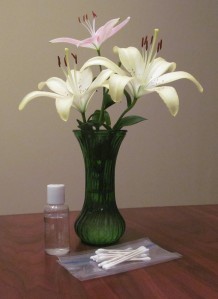
The flowers are extra, of course, but you might be able to enjoy them again if you have respiratory allergies.
The secret to never having another cold is to do this simple procedure as soon as you notice the first symptom.
You can be prepared by putting together a little “nip-it kit” in advance. No medications are needed. You will only need the following supplies:
One 3 oz. bottle
One fluid ounce of vodka (80 proof=40% alcohol)
Two ounces of filtered or distilled water
One plastic snack or sandwich bag
A dozen or so short cotton swabs
Fill the little bottle with the two liquids and put it in the plastic bag with a supply of Q-tips or other brand of swabs. This can be stored in a medicine cabinet, make-up drawer, glove box, purse, desk, gym bag or anywhere handy when needed.
Your first symptom of a cold might be sneezing, repeatedly clearing your throat or the sudden onset of sniffles. Take action immediately. Moisten a swab, gently run it up one nostril and sniff to coat the upper nostril and possibly get a hint of it in the back of the throat. There will not be enough liquid to allow inhaling it into the lungs. Then treat the other nostril. Within minutes the symptoms will disappear.
Why not make extra kits for family and friends? You could mix a half-pint (one cup) of vodka with two cups of water and fill eight bottles. You could get creative and add a small drop of peppermint oil to the larger recipe to add a little scent and flavor.
Never substitute rubbing alcohol because it is made from propane.
A child-proof cap should be used, of course, if you have children.
The Nip-it Trick is also effective if you have respiratory allergies due to smoke, pollens or scents. It can stop the reaction before you get congestion or a headache.
Enjoy!
